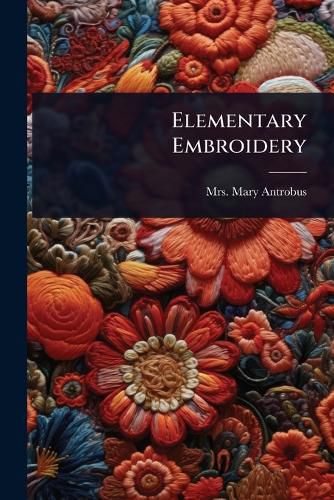Readings Newsletter
Become a Readings Member to make your shopping experience even easier.
Sign in or sign up for free!
You’re not far away from qualifying for FREE standard shipping within Australia
You’ve qualified for FREE standard shipping within Australia
The cart is loading…






"Elementary Embroidery" by Mrs. Mary (Symonds) Antrobus offers a comprehensive introduction to the art of embroidery. This vintage guide provides detailed instructions and illustrations for various embroidery techniques, making it an invaluable resource for both beginners and experienced needleworkers. From basic stitches to more intricate designs, the book covers a wide range of topics, ensuring a thorough understanding of the craft.
Originally published in the early 20th century, "Elementary Embroidery" reflects the aesthetic and practical concerns of its time. It offers insights into the materials and methods popular during that era. Whether you are interested in recreating historical embroidery or simply learning new skills, this book provides a solid foundation in the timeless art of needlework.
This work has been selected by scholars as being culturally important, and is part of the knowledge base of civilization as we know it. This work was reproduced from the original artifact, and remains as true to the original work as possible. Therefore, you will see the original copyright references, library stamps (as most of these works have been housed in our most important libraries around the world), and other notations in the work.
This work is in the public domain in the United States of America, and possibly other nations. Within the United States, you may freely copy and distribute this work, as no entity (individual or corporate) has a copyright on the body of the work.
As a reproduction of a historical artifact, this work may contain missing or blurred pages, poor pictures, errant marks, etc. Scholars believe, and we concur, that this work is important enough to be preserved, reproduced, and made generally available to the public. We appreciate your support of the preservation process, and thank you for being an important part of keeping this knowledge alive and relevant.
$9.00 standard shipping within Australia
FREE standard shipping within Australia for orders over $100.00
Express & International shipping calculated at checkout
"Elementary Embroidery" by Mrs. Mary (Symonds) Antrobus offers a comprehensive introduction to the art of embroidery. This vintage guide provides detailed instructions and illustrations for various embroidery techniques, making it an invaluable resource for both beginners and experienced needleworkers. From basic stitches to more intricate designs, the book covers a wide range of topics, ensuring a thorough understanding of the craft.
Originally published in the early 20th century, "Elementary Embroidery" reflects the aesthetic and practical concerns of its time. It offers insights into the materials and methods popular during that era. Whether you are interested in recreating historical embroidery or simply learning new skills, this book provides a solid foundation in the timeless art of needlework.
This work has been selected by scholars as being culturally important, and is part of the knowledge base of civilization as we know it. This work was reproduced from the original artifact, and remains as true to the original work as possible. Therefore, you will see the original copyright references, library stamps (as most of these works have been housed in our most important libraries around the world), and other notations in the work.
This work is in the public domain in the United States of America, and possibly other nations. Within the United States, you may freely copy and distribute this work, as no entity (individual or corporate) has a copyright on the body of the work.
As a reproduction of a historical artifact, this work may contain missing or blurred pages, poor pictures, errant marks, etc. Scholars believe, and we concur, that this work is important enough to be preserved, reproduced, and made generally available to the public. We appreciate your support of the preservation process, and thank you for being an important part of keeping this knowledge alive and relevant.